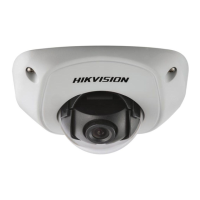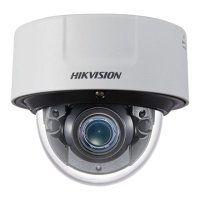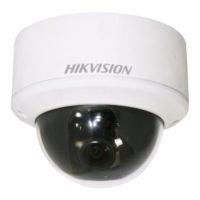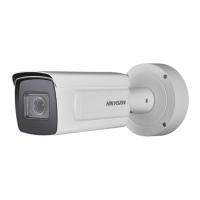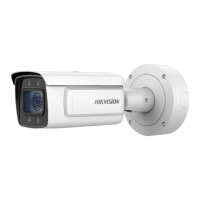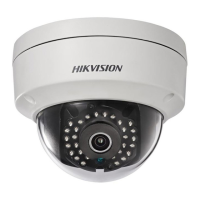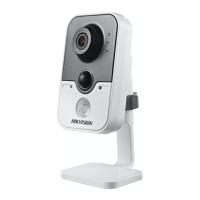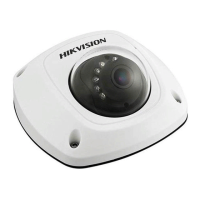Do you have a question about the HIKVISION DS-2CD7164-E and is the answer not in the manual?
| Type | IP security camera |
|---|---|
| PTZ control | Yes |
| Placement supported | Outdoor |
| Connectivity technology | Wired |
| Form factor | Dome |
| Product color | White |
| Protection features | Vandal proof |
| International Protection (IP) code | IP66 |
| Total megapixels | 1.3 MP |
| Maximum resolution | 1280 x 960 pixels |
| Supported video modes | 720p |
| Video formats supported | H.264, M-JPEG, MPEG4 |
| Supported graphics resolutions | 1280 x 960, 1280 x 720 (HD 720) |
| Pan range | -15 - 15 ° |
| Tilt angle range | 0 - 90 ° |
| Angle of rotation | 15 ° |
| Minimum illumination | 0.01 lx |
| Field of view (FOV) angle | 73 ° |
| Sensor type | CMOS |
| Optical sensor size | 1/3 \ |
| Optical zoom | - x |
| Zoom capability | - |
| Focus adjustment | 2.0 |
| Fixed focal length | 8 mm |
| Password protection type | User |
| Wi-Fi | No |
| Cabling technology | 10/100Base-T(X) |
| Supported network protocols | TCP/IP, HTTP, DHCP, DNS, DDNS, RTP, RTSP, PPPoE, SMTP, NTP, SNMP, HTTPS, FTP, 802.1x, QoS |
| Ethernet LAN (RJ-45) ports | 1 |
| DC output voltage | +12V |
| Power source type | PoE |
| Power consumption (max) | 4 W |
| Operating temperature (T-T) | -10 - 60 °C |
| Operating relative humidity (H-H) | 0 - 90 % |
| Depth | 97.5 mm |
|---|---|
| Width | 99.9 mm |
| Height | 46.5 mm |
| Weight | 250 g |
Details on FCC compliance and conditions for digital devices, including interference.
Information on CE marking, European standards, WEEE, and battery directives.
Overview of general capabilities like camera connectivity and stream encoding.
Details on HDMI, VGA, CVBS outputs and live view screen options.
Information on connecting SATA, network disks, and HDD properties.
Covers recording modes, types, time periods, and playback by events.
Details on data backup, alarm triggers, and exception management.
Includes user management, log search, and network interface configurations.
Information on SDK and development support for the DVR system.
Description of indicators, IR receiver, and USB interfaces on the front panel.
Details on the function of each button on the IR remote control.
Explains how to use a USB mouse for navigation and control.
Details on the soft keyboard icons and their functions for input.
Identifies and describes all ports and connectors on the rear panel.
Procedure for safely powering on, shutting down, and rebooting the DVR.
Step-by-step guide to initial setup using the setup wizard.
Instructions for adding online IP cameras and custom configurations.
Procedure for editing connected IP camera parameters and advanced settings.
Overview of the live view interface and status icons.
Details on single/multi-screen, auto-switch, recording, quick set, and playback.
Explains mouse controls for navigation and actions within the live view.
Features available when using an auxiliary monitor for live view.
Procedure to switch between main and auxiliary video outputs.
Description of icons in the quick setting toolbar for live view.
Configuration of output interface, dwell time, and camera order.
Diagnosing analog channel video quality and viewing results.
Steps to log out from the system and return to live view.
Setting up RS-485 parameters for PTZ camera control.
Customizing PTZ presets, patrols, and patterns for camera movement.
Enables the camera to move to a specified position when an event occurs.
Setting PTZ to move between key points with specified durations.
Makes the PTZ move according to a predefined patrol path.
Recording PTZ movement to create a path for playback.
Moves the PTZ camera according to predefined patterns.
Enables scanning in a horizontal direction within a predefined range.
Executes a linear scan within the predefined scan range.
Configures predefined park actions like scan or preset after inactivity.
Description of PTZ control panel icons and interfaces.
Setting resolution, frame rate, bitrate, and stream type for recording.
Setting up daily and holiday schedules for automatic recording.
Setting up motion detection areas, sensitivity, and trigger actions.
Enabling and disabling manual recording for channels.
Setting up special recording schedules for holidays.
Enabling redundant recording for data safety on a separate HDD.
Managing HDDs in groups to save recorded files.
Locking record files or setting HDD to read-only to prevent overwriting.
Methods for playing back recorded files by channel or time.
Steps to play back video from a specific channel.
Playing back video files within a specified time duration.
Searching and playing back files based on event types like alarm or motion.
Searching and playing back files using video tags.
Efficiently reviewing video by highlighting motion and speeding up non-motion.
Playing back files associated with system log entries.
Looking up and playing back files stored on external devices.
Includes frame-by-frame playback, smart search, and digital zoom.
Reviewing video file frame by frame for detailed inspection.
Locating motion detection events by analyzing specific areas dynamically.
Enlarging specific areas of the image up to 16 times.
Playing back recorded files of multiple channels in reverse.
Methods for exporting record files to backup devices quickly.
Steps for fast export of record files to backup devices.
Using video search to back up files to USB drives, HDDs, writers, or DVD-R/W.
Backing up event-related files using USB devices or DVD-R/W.
Exporting selected video clips during playback.
Operations for managing backup devices like USB drives and HDDs.
Configuring motion detection areas, sensitivity, and alarm response actions.
Setting up video loss detection and corresponding alarm response actions.
Triggering alarms when the lens is covered and setting response actions.
Diagnosing video quality and setting linkage actions for exceptions.
Configuring handling methods for various system exceptions.
Setting up network parameters like IP address, gateway, and DNS.
Advanced network configurations including PPPoE and Extranet Access.
Setting up Point-to-Point Protocol over Ethernet access.
Setting up Dynamic DNS (DDNS) for network access.
Synchronizing system date and time using an NTP server.
Using SNMP protocol for device status and parameter information.
Enabling UPnP for seamless network device discovery and connection.
Configuring multicast for live viewing of over 128 cameras.
Setting up Real Time Streaming Protocol for media servers.
Changing default server and HTTP ports for network access.
Setting up HTTPS port for secure web server communication.
Setting up email notifications for events like alarms or motion detection.
Enabling Telnet for advanced device access and configuration via commands.
Monitoring network traffic information like linking status and rates.
Obtaining network connection status, delay, and packet loss.
Procedure to test network delay and packet loss.
Exporting captured network data packets to backup devices.
Verifying the current network status and parameters.
Obtaining real-time network statistics like bandwidth usage.
Steps to initialize a newly installed hard disk drive before use.
Adding and configuring allocated NAS or IP SAN disks as network HDDs.
Organizing multiple HDDs into groups for recording.
Procedure to set up HDD groups for channel recording.
Setting HDD property to redundancy, read-only, or read/write.
Allocating specific storage quotas for recorded files per camera.
Monitoring the status of installed HDDs for maintenance.
Monitoring HDD reliability indicators using S.M.A.R.T. technology.
Checking for bad sectors on the HDD to determine its status.
Setting up alarms for HDD errors or abnormal status.
Setting up on-screen display elements like date, time, and camera name.
Setting up privacy mask zones to hide specific areas from view or recording.
Adjusting image parameters like brightness, contrast, and saturation.
Accessing information about the device, cameras, records, alarms, network, and HDD.
Displaying device name, model, serial number, and firmware version.
Checking the status of each connected camera.
Reviewing recording status and encoding parameters for each camera.
Displaying alarm information for the DVR system.
Checking network configuration details like IP address and status.
Displaying HDD status, capacity, and free space.
Searching, viewing, and exporting system operation, alarm, and exception logs.
Managing IP camera configuration files for backup and transfer.
Exporting DVR configuration for backup or importing to other devices.
Methods for upgrading DVR firmware via local backup or FTP.
Procedure for upgrading firmware using a local backup device.
Procedure for upgrading firmware via an FTP server.
Steps to restore the device to factory default settings.
Adjusting output resolution, system time, mouse speed, and wizard settings.
Setting up Daylight Saving Time adjustments.
Customizing device name, CVBS brightness, auto logout, and menu output.
Adding, deleting, and editing user accounts and their permissions.
Steps to create a new user with specific permissions.
Procedure to remove existing user accounts.
Modifying user information, password, and permissions.
Procedures for logging out, shutting down, or rebooting the DVR.
Solutions for issues with VGA/HDMI connections and monitor input modes.
Troubleshooting steps for issues related to HDD installation or initialization.
Resolving issues with frame rate and video output.
Troubleshooting no sound or noisy audio during live view.
Resolving image freezing during single or multi-channel playback.
Solutions for errors when searching for record files.
